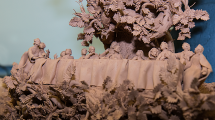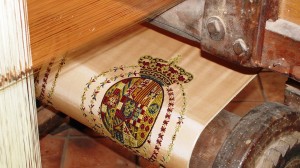Naples is undoubtedly the most devoted city to the history and cult of cribs: indeed a 1025 document already reported about a church of Santa Maria ad praesepe (now lost) and again in 1324 a ‘chapel of the nativity scene at Di Alagni residence’ was mentioned as existing in the nearby Amalfi.
In 15th century the first “figurarum sculptores” appeared; they realized sacred representations in Napoli’s churches and chapels. The most important are those by Pietro and Giovanni Alemanno brothers placed on the cribs in San Giovanni in Carbonara, in San Domenico Maggiore, in Sant’Egidio and Santa Chiara. Those are full size wooden polichrome statues, catched in a hieratic attitude of intense religiousness, placed before a painted background.
Around the middle of 16th century, the modern presepio rose, thanks to San Gaetano da Thiene who, in 1530, manufactured a crib made of wooden statues and dressed accordingly to the period in the oratory of Santa Maria della Stelletta at Ospedale degli Incurabili. During the following centuries, the painted background was replaced by landscapes in relief depicting the panorama of Naples. The figures, as well, were more and more reduced in dimensions, up to the realization of the first crib with movable figures, realized by the Scolopi fathers in 1627.
The Neapolitan crib golden century was certainly the 18th, a time when Naples became a ‘European capital’. Naples itself was responsible for the ‘secularization’ of the presepe, taking it away from the Church monopoly and fusing the deep and faithful religiosity with the epistemological and existential fervor of the new-born Enlightenment, with everyday realism, with the then dominant theatricality, with the wonder and delight of the late Baroque, with the attention to detail and the archaeological discoveries at Herculaneum and Pompei.
Naples took hold of the crib “as if to say that Christ was not born elsewhere or in a distant time, but here and now on this land and among its people“. And here is the Neapolitan crib, religiously sacred but also “secular and profane, cultured and worldly”, “we could say courteous to differentiate it from the old church nativity scene“.
In Naples the preparation of the crib begins on November 30th, in conjunction with the novena all’Immacolata (prayers to the Virgin Mary) and should be finished on December 8th. What makes suggestive analysis of such a unique art form, after almost three centuries, “is the interweaving of a number of constituent elements and motifs that refer not only to art history but to the human history as well, since in the Neapolitan crib the theme of the Nativity follows the historical and political evolution of the human society of the time, letting us know about the habits, customs, opinions and inclinations of the inhabitants of the city of Naples, mixing joy to sadness, the profane to the sacred, the mischief to devotion, severity to the most whimsical buffoonery “.
It could not be otherwise: the simple description of the Sacred event could be just of a little inspiration for such a creative and talentous population of Naples, full of sacred and religious respect, who would not dare to alter nor manipulate except with delicate interventions in the setting, in the attitudes and vestiture . But everything else not! On everything else the Vesuvian creativity has taken over with a ” progressive Neapolitanization of the crib by determining a process of growing production of locations, through the proliferation of scenes of everyday life, of paintings of local spirit “ almost overshadowing everything else, as if to ” deflect’ the attention due to the Mystery that, moreover, was also relegated to limited spaces and far from the visual fireworks of the ‘entire composition’ .
To understand what the crib was in ‘700 in Naples, just read the countless documents written by writers, poets and authors of the time, like the German poet transplanted in Copenhagen, a friend of Goethe, Friederike Brunwho claimed: “in the great cribs there are three main moments of the dramatic idyll, the first is the silent and lonely maternal joy in the hut, shared only with the good foster father and the devoted animals of the barn, while on the ruins of the ancient temple which houses the stable) the choirs of angels and the jubilant bright star rise up! The second is the arrival of the candid and pure pastors offering simple gifts like eggs, young doves, etc. The third is the light scene of the arrival of the holy kings and the offering of gifts to the radiant divine child. I noticed these three main moments in one of the richest of these Christmas theaters represented in separate rooms while the spaces in-between were deliciously filled: in part with the appearance of the singing angels and shepherds and partly with the procession of the holy Kings. Incredibly beautiful was the night scene with the shepherds. They aroused among their flocks of sheep, rams and goats, momentarily afraid, for the splendor of the heavenly people and the Gloria in Excelsis Deo!
Nothing is represented better than the stunned awakening of some and the joy that arouses in others … .the moon shines and we proceed with them through a silent landscape up to the holy barn . And this is the second major moment: the shepherds worship the newborn child and offer him the simple gifts. Here a woman is intent on drying clothes, another nursing a baby and the other still feeds the doves and chickens. Here you can peek into a country kitchen, in a well-stocked wine cellar … Pretty farmers, in the picturesque costumes of the kingdom of Sicily and the islands nearby, bring baskets with eggs, colorful chickens, doves and wonderful fruit; they walk with their husbands, old fathers and beautiful children in beautifully ordered groups…
Below the sky, in front of a hut, a fun lunch takes place, full of life as in Tenier, but always noble and pure! Two beautiful girls dance the national dance, the Tarantella, a little wilder than the Roman “salterello”. On another road through a woody and rocky landscape, through creeks and deep valleys, we follow a pompous parade of the three holy kings, rich in oriental gifts; they are accompanied by servants riding beautiful horses and camels, dromedaries and donkeys laden with precious objects: There’s a swarm of black and white slaves with their wives and children. Parrots and monkeys show their arts! The beautiful woman slaves of the magi, Greek or Persians, are always present. Sitting on horses, they are beautifully modeled, with Turkish – Persian dresses on, richly adorned with pearls and jewels ( always real ) …
The slaves bring silver vases adorned with jewels and filled with gold coins. The procession has reached the hut where, in a timid devotion, the mildest of women, kneeling next to the sweet baby, receives gifts and adoration … This, in a summary, is the Neapolitan crib as a whole”. A “mystical and poetic hallucination”, in short, as Herbert Petoia happily defined the Neapolitan crib!
By the way, on the Neapolitan nativity scene, other equally canonical and richly significant scenes are present: the choir of the Angels, the band of oriental, the “pezzentelle” souls … in a blaze of spectacularities, characters, animals, parts of furniture, food, colors, smells, crowded humanity … in short, a mess! That chaos ( apparent! ) is always well depicted on the crib, the mess that St. Alphonsus Liguori (the first person to use the Neapolitan language for religious songs) has poetically expressed in his Pastorale:
“quanno nascette Ninno a Betlemme
era notte e parea mezojuorno…
cu tutto ch’era vierno, Ninno Bello,
nascettero a migliaia rose e sciure…”
It’s not strange, then, that in Naples “the crib is the marriage of the Word, made flesh, with myths, fairy tales, stories and suggestions of a population who continues to preserve its past, despite years of Christianity … Myths, symbols and traditions make the crib a mix of stories that allow you to build a formidable phenomenon: cherish the tradition of a people expressing the unresolved assimilation of a new cult with the pre-existing civilization … Practically the crib tells the story of baby Jesus and the history of Naples”.
The need for God and attachment to the house and to the land are all present in the crib, and both ask, with devotion, for protection from the deity. This is Christmas in Naples, ” here Christmas is like in no other country … I would say: it is Napoli in Naples.” Unlike cribs of other nations and other Italian regions that retain an almost unchanging tradition, the Neapolitan crib is not crystallized into fixed and definite forms: the transformations it has undergone over the centuries are still alive and fruitful, forward-looking, thanks to the work of the passionate members of the Naples branch of the Italian Association of Friends of the Crib.
Enrico Fariello






















